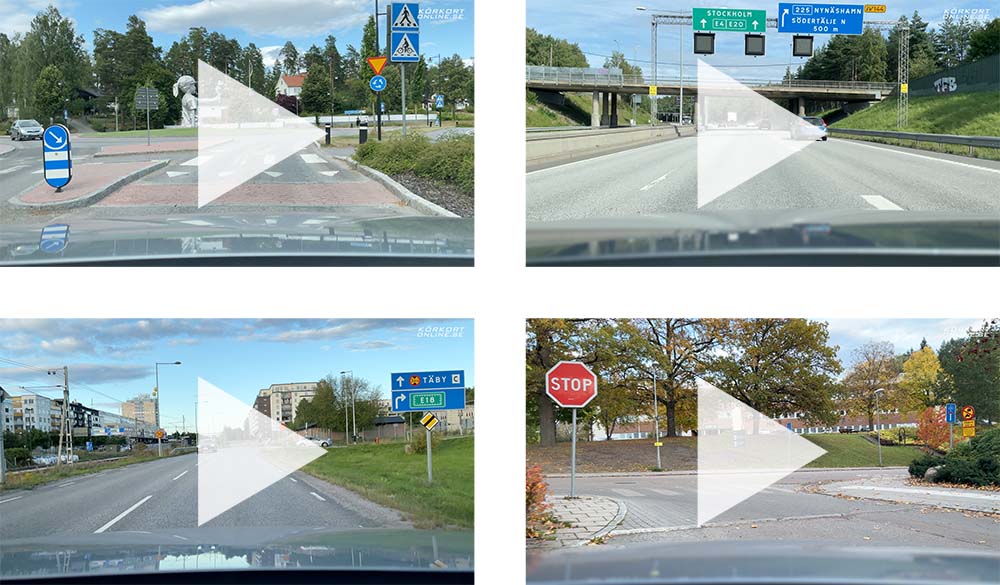Roundabout – driving licence theory
- Indicated with the sign Roundabout.
- Obligation to give way to all those already driving in the roundabout.
- Turn right to enter the roundabout, and drive in an anti-clockwise direction.
- Benefits of roundabouts:
- Safe – the low speeds rarely lead to serious traffic accidents.
- Easy to understand – it is very rare for cars to go in the wrong direction or to not give way when entering.
- More even traffic flow – traffic is spaced out, which means that the long queues that form at junctions with traffic signals are rare.
Driving on a roundabout
- Choose the most appropriate lane for your continued journey.
- Follow road signs and road markings.
- Use your indicators when changing lanes.
- You are only allowed to change lanes if you can do so without obstructing or endangering other road users.
- Facilitate other drivers’ lane changes by adapting your speed.
- Try to place yourself in the lane furthest to the right before exiting. This is not a requirement, but it increases traffic safety.
- You must indicate your intention to exit (i.e. to the right) when exiting the roundabout.
Driving straight ahead at a roundabout

1. Position your car to the right. Do not indicate.
2. When you are alongside the traffic island or a similar device that marks the exit before your intended exit, start indicating right.
3. Exit the roundabout.
Turning right at a roundabout

1. Position your car to the right, and preferably signal your intention by indicating to the right before entering the roundabout.
2. Keep to the right. Right-indicators must be turned on.
3. Exit the roundabout.
Turning left at a roundabout

1. Indicate to the left to signal to B and C that you intend to continue round to the left.
It is true that only indicating to the right when exiting the roundabout should give the same information. The problem is that many drivers fail to indicate to the right when they exit the roundabout. This could lead to B and C taking a risk. Perhaps C might think: “Most people drive straight ahead without indicating. I can take a chance and drive onto the roundabout.” This would result in a collision. By indicating to the left, you are signalling to others that: “I will be driving around the roundabout, so don’t even think about pulling out in front of me.”
2. Indicate to the right to show that you are exiting the roundabout.
3. Exit the roundabout.
Clarification on indicating left
Are there no clear rules about indicating left on roundabouts?
– No, indicating left is a grey area. The Swedish Transport Agency and Police are very clear that you must always indicate right when exiting. Unfortunately, the same clarity does not exist when it comes to indicating left.
The Swedish Transport Agency has published a brochure on roundabouts, which states that “there are no special requirements about using direction indicators when entering a roundabout” – why is that?
– The full quote is: “There are no special requirements about using direction indicators when entering a roundabout, as there is only one direction to drive.” This quote from the Swedish Transport Agency only focuses on the entry to the roundabout, stating that you must drive in the correct direction (anti-clockwise). This is quite a strange thing to focus on. Driving schools that advocate indicating to the left do so to signal the direction of the continued driving on the roundabout, not to signal entry to it.
Is it always the best option to indicate to the left if I intend to turn left?
– No. There are certain cases when this would not be appropriate. In the example, A is turning left, but chooses the right-hand lane (not recommended). If A indicates to the left, B will think that A intends to change lane. The clearest option is for A to refrain from indicating to the left. Preventing confusion concerning lane-changes is more important in this situation than signalling the direction of the continued driving.

You want to continue straight ahead. When you exit the roundabout, you must indicate right.
There are also some curved roads that are not roundabouts. Here, you are approaching a round-shaped junction that is not a roundabout. You can see this by the absence of road signs denoting a roundabout/obligation to give way upon entry. You can also see the back of a ‘Give way’ sign that applies to traffic coming from the left (A).
Latest forum posts
- << Pedestrian crossings etc.
- Roundabout ↑↑
- Stop & park >>




